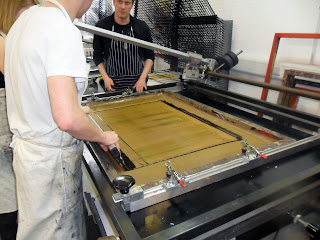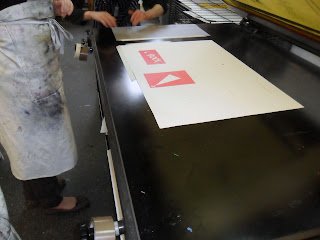Key points:
- separate black and white positives needed for each colour
- Can hand paint the emulsion onto the screen
- The UV light travels through the paper, emulson and print
- Postives need to be laser print noy inkjet or photcopies
- try to avoid any overlap or tiling as will show when exposed
- If do need to join use scotchtape not sellotape
- Hobbs at St Pauls is a good printer
- Usually print light to dark
- use acrylic paint
We practised two colour seperation
Clean screen
- Remove any tape from the screen
- Clean stencil off the screenwith diluted sulpuric acid
- Switch on extractor fan
- Start with inside out first
- Clean with sponge on both sides
- Then blast with the jet wash
- Important hat thoroughly clean
- Dry in rediator bins for 10 mins
Print image
- Change image from colour to grayscale
- Then increase level of black
- If tonal adjust the half tones
Coat screen with emulsion- Get help from staff
Dry for ten mins.
Expose image
- Place positives in centre of box
- Don't put screen on glass if emulsion is wet
- Screen
- Cover and clamp
- Different types of positives have different exposure times
Wash in wash out booth
- Inside first, Not full blast just wet with shower
- Wash less if want a grainy print, more if solid
The colour
- Mix binder with acrylics to prolong drying time
- about 40% acrylic max (less if want more transluscent)
Mask of any yellow areas (exposed) around the edge of the screen
Line up the master sheet under the screen on the table and mask off corner when in correct position
Fix frame into table and clamp down
Chose a suitable length squiggy
Hold Sqiggy at a 45 degree angle, dip in paint to lubricate. Then puull back strongly over screen. Push forward then lift up back over paint.
Lift frame then flood the screen by pushing squiggy back over screen.
Check the placement of the frame on the master sheet. If Ok mask of with double layer of masking tape so You have an edge to line up later prints.
Then print as many copies as required
For secong colour do secongd colour on master sheet then place the first colour underneath to line up correctly
I used a separate screen as I needed to use orange and blue paint When using two colours it is worth masking the second image off to avoid transfering colour.
Thouroughly wash and dry screen in between colour changes.













No comments:
Post a Comment